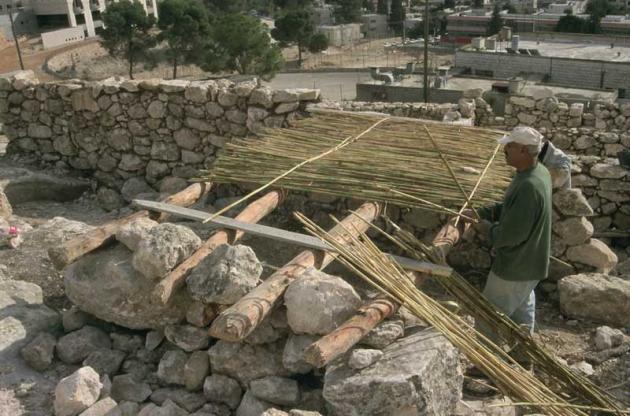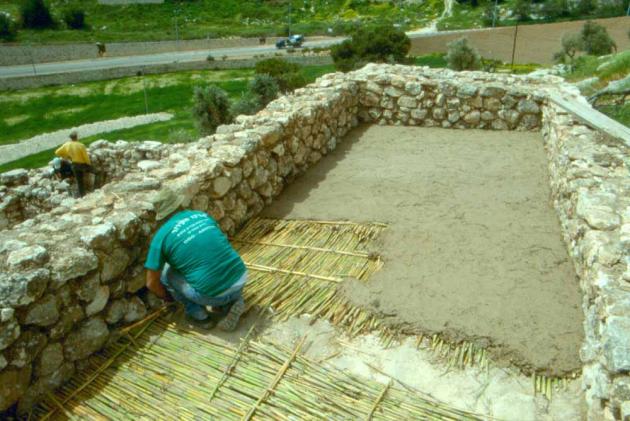First-century roofs in Galilee were usually flat, consisting of timber beams (usually sycamore or cypress) set into the walls about 2-2½ metres over the floor, supporting branches or reeds which retained thick layers of earth plaster.
While this general concept was clarified relatively early on in the project, specific questions about the materials and techniques used to construct flat earthen roofs remained unanswered. For example, what size and how far apart should the logs be? How was the roof plaster formulated and applied?
For these details, ethno-archaeological surveys were conducted of Arab villages where traditional flat earthen roofs could still be found. We examined houses that are being rapidly being replaced by modern construction and conducted numerous interviews with those who recall having built them. There were many different opinions as to the best way to construct flat earthen roofs, but we had to answer most questions ourselves by building these roofs at Nazareth Village.
Tree trunks of relatively straight, durable and available timber (usually cypress) are trimmed, debarked, and their extremities painted with hot tar to resist decay. These are set halfway into the wall masonry and slightly graded to direct rainwater into house cisterns.
Abundant and fast-growing stands of natural cane provided a highly-favoured roofing material for ancient builders. Such cane was certainly available in first-century Nazareth, as the name of the adjacent village of Kfar Kana suggests. Cane mats woven together offer a strong and lightweight framework to retain the earthen component of the roof.
As such roofing styles have gone out of fashion, we were unable to employ roofers experienced with using this material. Only after building several trial roofs of timber/cane construction did we feel confident enough to proceed.


To retain the bottom of the roof, 2-3 cm thick canes are set across timbers in overlapping mats, bounded together with natural fibre (kitan). The cane is set flush to the wall but not inset, to avoid weakening the wall.
The walls are then built up over the timbers to secure them and also to create a parapet wall around the roof. The parapet will help retain the roof and make it a safer place for the many household activities which took place there.
A layer of wet roof plaster is then applied over the caning. This plaster – a mixture of earth, straw and lime – will help cement the cane together and provide a firm footing for the upper layers of plaster.
A mixture of dry earth, ash and chalk is then poured over the plaster just as it begins to stiffen up. This layer, usually 10-15 cm thick, constitutes the bulk of roof plaster and is applied dry to minimise shrinkage and cracking. A heavy roof roller is then used to compact the earth as much as possible. By now it is possible to walk on the roof, which is beginning to feel more like a road than the top of a house.
Water is then lightly sprinkled over the dry pack to compact it even further and provide a moist surface for the final layer of wet earth plaster. The plasters are best applied in the afternoon, minimising cracking by letting the roof dry slowly overnight.
Maintenance of the houses is a necessary chore, not only to preserve the investment in these buildings but also to further our understanding concerning life in the First Century.
House maintenance involves annual re-compaction of roof plaster following the first autumn rains, using the stone roller pictured on the right above, re-pointing the parapet walls and copings, and re-plastering the roof as illustrated.